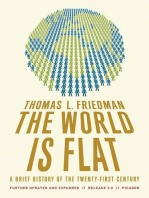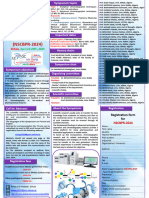0 ratings0% found this document useful (0 votes)
22 viewsEnglish
English
Uploaded by
Moh Nadjib RebiziCopyright:
© All Rights Reserved
Available Formats
Download as PDF or read online from Scribd
English
English
Uploaded by
Moh Nadjib Rebizi0 ratings0% found this document useful (0 votes)
22 views8 pagesOriginal Title
english
Copyright
© © All Rights Reserved
Available Formats
PDF or read online from Scribd
Share this document
Did you find this document useful?
Is this content inappropriate?
Copyright:
© All Rights Reserved
Available Formats
Download as PDF or read online from Scribd
Download as pdf
0 ratings0% found this document useful (0 votes)
22 views8 pagesEnglish
English
Uploaded by
Moh Nadjib RebiziCopyright:
© All Rights Reserved
Available Formats
Download as PDF or read online from Scribd
Download as pdf
You are on page 1of 8
ENGINEERINGCHEMISTRY-|
FIRST SEMESTER
UNIT-1
ATOMIC STRUCTURES, MOLECULAR MASS, ACIDS AND
BASES
4.1 ATOMIC STRUCTURE
INTRODUCTION
Chemistry is a branch of science that deals with the study of the
nature of matter, its composition, occurrence, isolation, methods of
preparation, properties and uses.
An atom is the smallest form of a chemical particle that retains the
properties of the particle. The word ‘atom’ comes from the Greek word
‘atomos’, meaning ‘unable to be cut’. The original meaning of atom was the
smallest, indivisible form of a chemical particle. Now we know how to divide
atoms into sub-atomic particles, the definition of an atom includes the concept
that the particle must retain its chemical properties.
ATOM
An Atom is the smallest invisible particle of element, having all the
characteristics of the parent element, which can neither be created nor
destroyed by any chemical change. It cannot exist freely. It is the ultimate
particle of an element, which may or may not have independent existence.
The atoms of certain elements such as hydrogen, oxygen, nitrogen,
etc.do not have independent existence where as atoms of helium, neon,
argon, etc. do have independent existence. All elements are composed of
atoms.
Fundamental particles of an atom
Almost the atoms of all elements are made up of three main particles known
as fundamental particles. They are electrons, protons and neutrons. Hydrogen
is the only element that do not have neutron.
PROTON
1.The proton is a positively charged particle.
2.lt has unit positive charge and unit mass. The mass of proton is
approximately equal to the mass of one hydrogen atom. It is equal to
1.00732 amu
3.The proton is present in atoms of all the elements.
4. he protons are present inside the nucleus of an atom
ELECTRON
1. The electron is a negatively charged particle
2. Ithas unit negative charge and negligible mass.
3. The mass of and electron is about 1/1837 of mass of a hydrogen atom.
4, Electrons are present in all the atoms,
5. Electrons are revolving around the nucleus in various circular orbits (shell).
NEUTRON
1. The neutron is a neutral particle. Hence, it has no charge.
2. It has unit mass. The neutron is present in atoms of all elements except
hydrogen. The mass of a neutron is slightly greater than the mass of a
proton. It is equal to 1.00871 amu
3. Neutron is present inside the nucleus of an atom,
ATOMIC NUMBER (Z)
The atomic number is the number protons present in the nucleus of an
atom or number of electrons revolving around the nucleus in an
atom. Based on the carbon standard the atomic mass of an element may
be defined as the ratio between the mass of one atom of the element and
1/12" of mass of an atom of carbon
‘Atomic number= No of protons=No of electrons
MASS NUMBER (A)
The mass number of an element is given by the total number of protons and
neutrons present in the nucleus of an atom. A= (P+N)
Therefore the number of neutrons is = A-Z.
ISOTOPES
The isotopes are atoms of the same elements having the same atomic
number but different mass number.
e.g. Isotope of oxygen: 40", 607, 0%.
ISOBAR
Isobars are the atoms of different elements having the same mass number
but different atomic number.
e.g. 920, oyPa™,
STRUCTURE OF ATOM
The atom consists of two parts. They are 1.The central nucleus 2.The outer
extra nuclear part.
1. The central Nucleus:
The nucleus is the central part of an atom consists of protons and neutrons.
Since the protons are positively charged particle and neutrons are neutral, the
nucleus is always positive part of an atom. The entire weight of an atom is
present only in the nucleus.
2. The outer extra nuclear part,
1
It is the part around the nucleus. It contains all electrons of an atom. It
is the negative part of the atom. The electrons are revolving around the
nucleus in a regular path called shell or orbit or energy levels.
The shells or orbits are numbered, as 1,2,3,4 etc from the nucleus.
They are also known as K, L, M, N Shell or orbit.
Each shell can accommodate only certain number of electron, which is
given by the formula 2n? where the ‘n’ is the number of the shell
Therefore, the numbers of electrons that are accommodated in the 1st,
2nd, 3rd shell respectively are 2,8,18.
4. The electrons present in the outer most orbit is called as valence
electron.
5. The atom as whole is a neutral one. Since the number of protons
(positively charges) is equal to the number of electrons (negative
charges).
The atomic structure of Sodium atom is given below.
‘Atomic structure of Na atom
At.no-11(11p,116)
Mass.n0=23(11p.12n)
x
x *
yk)” K-shell 2e—
‘ @:
Kl: Lshellse
SF ashen ae
2 x
Nucleus
FORMATION OF CATION AND ANION
Example.1
1. Hydrogen atom
Number of proton
{number of positive charge is +1)
Number of electron = 1 (number of negative charge is -1)
Number of neutron
1 ELECTRON
4g) ————>
Hydrogen atom Hydrogen ion (H*) or proton
So,Z=1,A=1
When hydrogen atom losses its outer most electron, it has only one proton.
The H becomes H’ ion due to the loss of one electron. Hence, the H” ion is
called as proton.
H —— H (proton) +1e
A-Z=1-1=0(No neutron)
FORMATION OF CATION AND ANION
Atom as whole is a neutral one, since the number of proton and electrons are
equal. An atom becomes an ion only when there is a gain or loss of an
electron. Anion (-ve ion) is formed by the gain of electron. Similarly, cation
(positive) is formed by the loss of electron.
Na atom 14p,110(114.14-) chlorine atom-17p,17e(174.17-)
*
XK
x
x
[Na
*
xx
Afterlosingane- after receiving an e-:Ci.sci- anion
Na Nat cation
twat (114,10-) ch (17+.18-)
£028
CATION FORMATION
Na (Atom) 212, Na* (cation)
When an atom losses an electron it becomes cation. When electron is
transferred from sodium atom to chlorine atom the sodium atom becomes
cation.
ANION FORMATION
When an atom gains an electron, it becomes anion, From the above example,
chlorine atom gains an electron from sodium it becomes an anion.
ci (Atom) *72, cI (Anion)
ELECTRONIC CONCEPT OF OXIDATION AND REDUCTION
‘The electronic concept of oxidation and reduction can be explained as below.
OXIDATION
Oxidation is a process that involves removal (loss) of electrons.
Example:
Na ae, Nat
K ae, Ke
Hl Ae, ys
Here Na, K and H are oxidised into Na’, K* and H' respectively.
REDUCTION
Reduction is a process that involves addition (gain) of electrons,
Example:
cl He ocr
. Hem
Br Heat
Here Cl, F and Br are reduced into Cl’, F’ and Br” respectively
What is chemical bonding?
When two atoms in a molecule strongly tend to remain together, they
are said to be in chemical bonding with each other. In other words, it is said
that a chemical bond has been established between the two atoms. Thus,
“A chemical bond may be defined as an attraction between the
two atoms in a molecule”
Why do atoms combine?
There is a deep relationship between the properties and the electrons
lying in their outermost orbits. The elements having same number of valency
electrons have similar properties. The elements in the zero groups have two
or eight electrons are inactive chemically.
OCTET RULE
The inert gases have the stable configuration of eight electrons (octet
structure) in their outer most orbits except helium which 2 have only electrons.
Due to their stable octet structure, these gases are inert in nature. They do
not chemically react with other elements. “According to Lewis “octet theory,
all the elements with an unstable or incomplete electronic configuration
have a tendency to attain the stable electronic configuration of the
nearest inert gas configuration either by complete transfer of valence
electron from one atom to another or by mutual sharing of valence
electron between the atoms”. This tendency to attain the stable electronic
configuration is responsible for the formation of chemical bonding,
INERT GASES OR NOBLE GASES
Element | Atomic number | Electronic configuration
Helium [2 2 (H-1 unstable-for stable-2)
Neon 10 28
Argon | 18 2.88
Krypton [36 28,188
Xenon | 84 2,8,18,18,8
Radon [86 2,8,18,32,18,8
TYPES OF BONDING
The process by which unstable atoms acquire a stable configuration has been
found to take place in two different ways
1, The complete transfer of valency electrons from one atom to another.
This is called lonic bond (or) Electrovalent bonding.
2. The mutual sharing of (pair of) valency electrons between —_—the
atoms. The shared pair of electrons is given by both atoms. This is called
as Covalent bonding
lonic (or) Electrovalent Bond
This type of bond is formed as a result of the complete transfer of one
or more electrons from one atom to other.
This bond is generally present in inorganic compounds
Example __: Formation of Sodium Chloride
Explanation :
The atomic number of sodium is 11(11P/11e=114/11-)
The electronic configuration is 1s”, 2s’, 2p®, 3s"(2, 8, 1).
The electron dot formula is Na.
Sodium has only one electron in its outermost orbital
The atomic number of chlorine is 17(17p/17e=174/17- )
‘The electronic configuration is 1s, 2s”, 2p®, 3s*, 3p (2, 8, 7)
The electron dot formulais ¢ *
:Cle
Na atom 11p,110(114.11-) chlorine atom-17p.17e(174.17>)
xe
xX
OO
i
o/ /
a
ee
ee.
}
YN
x N\
° oe
At i a = CL SCh
fer losing ane- ia, ANerTeeceluing an e:Cl.yck anion
hoe (144,10-) pi dd
Bei2e ECOFCI:288
Neon (28) Argon(2.8,8)
Sodium has one electron in excess of the stable neon configuration (2, 8).
and chlorine is one electron short of the stable argon configuration (2, 8, 8).
When these atoms are in contact, sodium has a tendency to lose its single
valence electron and chlorine has a tendency to accept a single electron to
reach the stable electronic configuration of the nearest inert gas. By
transferring one electron from sodium to chlorine, sodium acquires a unit
positive charge while by gaining the electron; the chlorine atom acquires a
unit negative charge.
Now sodium has attained the stable electronic configuration of neon
(2,8).Similarly chlorine has attained the stable electronic configuration of
neon(2,8,8).
These charged ions are held together by electrostatic attraction and form a
neutral molecule of sodium chloride.
[ S
Nat + [ | —[Ne*
Compounds formed in this way are called electrovalent or ionic
compounds and the bond is called lonic bond or electrovalent bond.
Covalent bond
Formation of a covalent compound(NH3
This type of bond is formed by the mutual sharing of pair of electrons
between two atoms each atom supplying equal number of electrons for
sharing. The covalent bond is indicated by (-).
Example _ : Formation of Ammonia (NHs).
Explanation :
H
* H H
+ * l
He ++Ne 44H (H#) NG eH H-N-H
The atomic no of Nitrogen is 7. (E.C:2, 5 unstable)
The electronic configuration 1s%,2s”,2p’.
The electron dot formula of Nis AJ «
7
The electron dot formula is H-
The atomic number of Hydrogen is 1
‘The electronic configuration 1s‘(E.C:1 unstable)
To get stable electronic configuration Nitrogen shares its three electrons with
electrons of three Hydrogen atoms.
Ammonia is formed by the covalent bonding between one atom of
hydrogen and three atoms of hydrogen. Nitrogen has five valence electrons.
The electronic configurationis2,5(unstable). Therefore, it needs three
electrons to attain stable inert gas configuration. Hydrogen has one electron
So it needs one electron to attain the stable inert gas configuration of Helium
The nitrogen atom shares three of its valence electron with three hydrogen
atom forming the covalent bonds.
All the four atoms attain the stable configuration. Thus, the covalent bond is
formed,
QUESTIONS
PART-A
- What is the charge of a nucleus of an atom?
Define isotopes
Define isobars
|. What is the charge of an anion?
. What is the charge of a cation?
. Define oxidation
Define reduction
Nogsens
PART-B
1, We can call H* ion as a proton. How?
2. Atomic number and mass number of an element is 9 & 19 respectively.
‘What is the number of neutrons present in the atom of the element?
3. Explain the formation of a cation with example?
4. Explain the formation of an anion with example?
PART-C
- Why do atoms of elements combine?
Which is more stable Na or Na” Why?
Explain the formation of NaCl?
Explain the formation of NH3?
. While atoms of most of the elements are unstable but atoms of noble gases
are stable. Explain?
Which is more stable Cl or Cr Why?
@RENS
You might also like
- The Subtle Art of Not Giving a F*ck: A Counterintuitive Approach to Living a Good LifeFrom EverandThe Subtle Art of Not Giving a F*ck: A Counterintuitive Approach to Living a Good LifeRating: 4 out of 5 stars4/5 (5987)
- The Gifts of Imperfection: Let Go of Who You Think You're Supposed to Be and Embrace Who You AreFrom EverandThe Gifts of Imperfection: Let Go of Who You Think You're Supposed to Be and Embrace Who You AreRating: 4 out of 5 stars4/5 (1112)
- Never Split the Difference: Negotiating As If Your Life Depended On ItFrom EverandNever Split the Difference: Negotiating As If Your Life Depended On ItRating: 4.5 out of 5 stars4.5/5 (898)
- Hidden Figures: The American Dream and the Untold Story of the Black Women Mathematicians Who Helped Win the Space RaceFrom EverandHidden Figures: The American Dream and the Untold Story of the Black Women Mathematicians Who Helped Win the Space RaceRating: 4 out of 5 stars4/5 (932)
- Grit: The Power of Passion and PerseveranceFrom EverandGrit: The Power of Passion and PerseveranceRating: 4 out of 5 stars4/5 (619)
- Shoe Dog: A Memoir by the Creator of NikeFrom EverandShoe Dog: A Memoir by the Creator of NikeRating: 4.5 out of 5 stars4.5/5 (546)
- The Hard Thing About Hard Things: Building a Business When There Are No Easy AnswersFrom EverandThe Hard Thing About Hard Things: Building a Business When There Are No Easy AnswersRating: 4.5 out of 5 stars4.5/5 (357)
- Her Body and Other Parties: StoriesFrom EverandHer Body and Other Parties: StoriesRating: 4 out of 5 stars4/5 (831)
- Elon Musk: Tesla, SpaceX, and the Quest for a Fantastic FutureFrom EverandElon Musk: Tesla, SpaceX, and the Quest for a Fantastic FutureRating: 4.5 out of 5 stars4.5/5 (477)
- The Emperor of All Maladies: A Biography of CancerFrom EverandThe Emperor of All Maladies: A Biography of CancerRating: 4.5 out of 5 stars4.5/5 (275)
- The Little Book of Hygge: Danish Secrets to Happy LivingFrom EverandThe Little Book of Hygge: Danish Secrets to Happy LivingRating: 3.5 out of 5 stars3.5/5 (425)
- The World Is Flat 3.0: A Brief History of the Twenty-first CenturyFrom EverandThe World Is Flat 3.0: A Brief History of the Twenty-first CenturyRating: 3.5 out of 5 stars3.5/5 (2272)
- The Yellow House: A Memoir (2019 National Book Award Winner)From EverandThe Yellow House: A Memoir (2019 National Book Award Winner)Rating: 4 out of 5 stars4/5 (99)
- The Sympathizer: A Novel (Pulitzer Prize for Fiction)From EverandThe Sympathizer: A Novel (Pulitzer Prize for Fiction)Rating: 4.5 out of 5 stars4.5/5 (125)
- Devil in the Grove: Thurgood Marshall, the Groveland Boys, and the Dawn of a New AmericaFrom EverandDevil in the Grove: Thurgood Marshall, the Groveland Boys, and the Dawn of a New AmericaRating: 4.5 out of 5 stars4.5/5 (270)
- A Heartbreaking Work Of Staggering Genius: A Memoir Based on a True StoryFrom EverandA Heartbreaking Work Of Staggering Genius: A Memoir Based on a True StoryRating: 3.5 out of 5 stars3.5/5 (232)
- Team of Rivals: The Political Genius of Abraham LincolnFrom EverandTeam of Rivals: The Political Genius of Abraham LincolnRating: 4.5 out of 5 stars4.5/5 (235)
- On Fire: The (Burning) Case for a Green New DealFrom EverandOn Fire: The (Burning) Case for a Green New DealRating: 4 out of 5 stars4/5 (75)
- The Unwinding: An Inner History of the New AmericaFrom EverandThe Unwinding: An Inner History of the New AmericaRating: 4 out of 5 stars4/5 (45)
- Flyer of NSC-2024 - SkikdaDocument2 pagesFlyer of NSC-2024 - SkikdaMoh Nadjib RebiziNo ratings yet
- Synthesis Spectroscopic SQUEEZE methodXRD InteractDocument26 pagesSynthesis Spectroscopic SQUEEZE methodXRD InteractMoh Nadjib RebiziNo ratings yet
- Level 3 ChemistryDocument37 pagesLevel 3 ChemistryMoh Nadjib RebiziNo ratings yet
- English For Chemical EngineersDocument1 pageEnglish For Chemical EngineersMoh Nadjib RebiziNo ratings yet












































